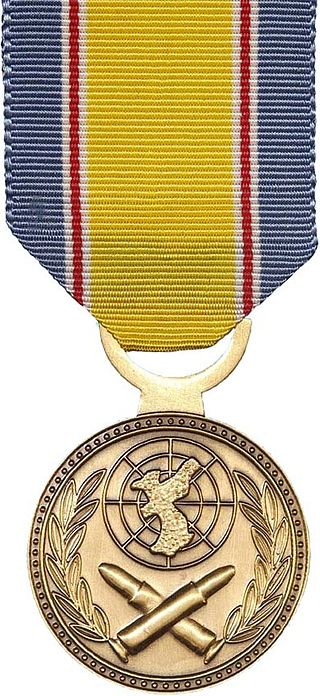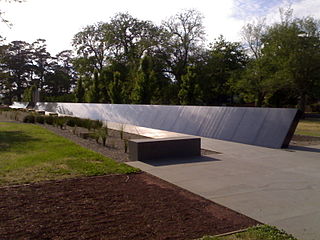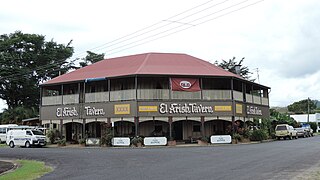
The Australian Army is the principal land warfare force of Australia, a part of the Australian Defence Force (ADF) along with the Royal Australian Navy and the Royal Australian Air Force. The Army is commanded by the Chief of Army (CA), who is subordinate to the Chief of the Defence Force (CDF) who commands the ADF. The CA is also directly responsible to the Minister for Defence, with the Department of Defence administering the ADF and the Army.

Anzac Day is a national day of remembrance in Australia and New Zealand that broadly commemorates all Australians and New Zealanders "who served and died in all wars, conflicts, and peacekeeping operations" and "the contribution and suffering of all those who have served". Observed on 25 April each year, Anzac Day was originally devised to honour the members of the Australian and New Zealand Army Corps (ANZAC) who served in the Gallipoli Campaign, their first engagement in the First World War (1914–1918).

The Returned and Services League of Australia (RSL) is a support organisation for people who have served or are serving in the Australian Defence Force.

Keith Payne, is an Australian recipient of the Victoria Cross, the highest decoration for gallantry "in the presence of the enemy" awarded to members of the British and Commonwealth armed forces. Payne's VC was awarded for his actions during the Vietnam War. Aged 89, he is the last living Australian recipient of the original "Imperial" Victoria Cross.

The Korean War Service Medal, also known as the Republic of Korea War Service Medal (ROKWSM), is a military award of South Korea which was first authorized in December 1950.

Southport is a coastal suburb in the City of Gold Coast in Queensland, Australia. In the 2016 census, Southport had a population of 31,908 people. It contains the Gold Coast central business district.

Tewantin is a rural town and locality in the Shire of Noosa, Queensland, Australia. In the 2016 census, Tewantin had a population of 10,920 people. Tewantin was the original settlement in the Noosa region and is one of its three major centres today.

1st Battalion, Royal Australian Regiment is a regular motorised infantry battalion of the Australian Army. 1 RAR was first formed as the 65th Australian Infantry Battalion of the 34th Brigade (Australia) on Balikpapan in 1945 and since then has been deployed on active service during the Korean War, the Malayan Emergency, the Vietnam War, Unified Task Force in Somalia, East Timor, Iraq War and Afghanistan. Additionally, the battalion has deployed on peacekeeping and other operations to a number of countries including Japan, Rifle Company Butterworth, Timor Leste, Solomon Islands, Tonga and the Philippines. 1 RAR remains one of the Australian Army's most readily deployed units sending individuals and detachments to domestic, regional and other enduring operations. The battalion is currently based in Coral Lines at Lavarack Barracks, Townsville, Queensland, where it forms part of the 3rd Brigade.

Canungra is a rural town and locality in the Scenic Rim Region, Queensland, Australia. In the 2016 census, the locality of Canungra had a population of 1,229 people.

Australia's involvement in the Vietnam War began with a small commitment of 30 military advisors in 1962, and increased over the following decade to a peak of 7,672 Australian personnel following the Menzies Government's April 1965 decision to upgrade its military commitment to South Vietnam's security. By the time the last Australian personnel were withdrawn in 1972, the Vietnam War had become Australia's longest war, eventually being surpassed by Australia's long-term commitment to the War in Afghanistan. It remains Australia's largest force contribution to a foreign conflict since the Second World War, and was also the most controversial military action in Australia since the conscription controversy during World War I. Although initially enjoying broad support due to concerns about the spread of communism in Southeast Asia, an increasingly influential anti-war movement developed, particularly in response to the government's imposition of conscription.

The Australian Ex-Prisoners of War Memorial was dedicated on Friday, 6 February 2004. It is located on the southern approaches to the Ballarat Botanical Gardens, on Wendouree Parade and adjacent to Lake Wendouree.
The Many Flags campaign was an initiative by United States President Lyndon Johnson to get U.S. allies in Asia and the Pacific to participate in the Vietnam War in support of South Vietnam. While it served a military purpose, the program was also a propaganda effort by Johnson to enlist Free World forces in the Cold War against communism. The U.S. supported the Allied forces through direct monetary aid, military contracts, logistic aid, and various forms of economic compensation.

Australia entered the Korean War on 28 September 1950, following the invasion of South Korea by North Korea. The war's origins began in the context of Japan's defeat in World War II which heralded the end to 35 years of Japanese occupation of the Korean Peninsula. The surrender of Japan to the Allied forces on 2 September 1945 led to the division of Korea into two countries, which were officially called the Democratic People's Republic of Korea (DPRK) and the Republic of Korea (ROK), with the DPRK being occupied by the Soviet Union, and the ROK, below the 38th Parallel, being occupied by the United States (US).

El Arish is a rural town and locality in the Cassowary Coast Region, Queensland, Australia. In the 2016 census, the locality of El Arish had a population of 344 people.
The Canadian Forces were involved in the 1950–1953 Korean War and its aftermath. 26,000 Canadians participated on the side of the United Nations, and Canada sent eight destroyers. Canadian aircraft provided transport, supply and logistics. 516 Canadians died, 312 of which were from combat. After the war, Canadian troops remained for three years as military observers.

The United Nations Memorial Cemetery in Korea, located at Tanggok in the Nam District, City of Busan, Republic of Korea, is a burial ground for United Nations Command (UNC) casualties of the Korean War. It contains 2,300 graves and is the only United Nations cemetery in the world. Laid out over 14 hectares, the graves are set out in 22 sites designated by the nationalities of the buried servicemembers.

Anzac Day is a day of remembrance in Queensland, Australia. It is a public holiday held on 25 April each year. The date is significant as the Australian and New Zealand troops first landed at Gallipoli in World War I on 25 April 1915.

The Southport RSL is a sub-branch of Returned and Services League of Australia (RSL) in Southport, Gold Coast in South East Queensland, Australia. Their building is at 36 Scarborough Street, Southport. The Southport RSL is a registered not-for-profit charity.

Military Memorials of National Significance meet a set of ten criteria laid down in the Military Memorials of National Significance Act of 2008 which received assent in the Australian Government on 12 Jul 2008. All such memorials are on public land within a State or the Northern Territory but outside the Australian Capital Territory. The Act allowed memorials outside Canberra to be recognised as National Memorials and the first to receive such recognition was the Australian Ex-Prisoners of War Memorial at Ballarat. The Member for Ballarat, Catherine King was instrumental in passing this legislation.

















